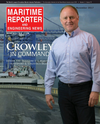
Page 55: of Maritime Reporter Magazine (November 2017)
The Workboat Edition
Read this page in Pdf, Flash or Html5 edition of November 2017 Maritime Reporter Magazine
he impact of LNG car- “The Ostensjo RAstarDF tugs are actu- breaking hull form with heavier rein- wrote these lines, Wärtsilä — its designs rier and FSRU ? eets ally quite different from the TundRA de- forcement.” The Swedish port of Lulea are the basis of 1,000 tugs worldwide worldwide is a sig- sign built for Group Ocean in Quebec,” is understood to have already tendered — launched the HYTug concept and “T ni? cant and positive says Mr. Fitzpatrick. “The Ostensjo tugs to European shipyards for a powerful encapsulated gains made in mechani- one for our tug business,” Robert Allan use our standard escort tug hull form (diesel-electric) hybrid TundRA of 100 cal and electric hybrid propulsion. The president and CEO, Mike Fitzpatrick, with some reinforcement to achieve a t BP based on the Group Ocean vessel. designer and builder of the 20 DF and tells Maritime Reporter & Engineering relatively light Ice Class, whereas the Robert Allan isn’t alone in proliferat- 34 DF LNG is known for early LNG
News. “The owners of LNG carriers and TundRA design is a specialized ice- ing new, “high-spec” tug designs. As we tug design deliveries to China and the
FSRU’s demand much higher quality and higher performing tugs than other shippers for a variety of good reasons.”
In fact, the push to LNG by Europe is real: The Continent is out of oil but well- supplied by natural gas and U.S. re? nery products. Europe’s port cities strive to be carbon-free harbors that nevertheless give free reign to LNG supply barges or
LNG-fueled cruise ships. Marine fuel and emissions are being strictly moni- tored, with the monitoring technology offered up by classi? cation societies.
For over two years, now, MARPOL Tier
III nitrogen oxide rules have been in ef- fect for vessels with engines equal to or greater than 130 kW, and new Emissions
Control Areas and the 2020 (or 2025) 0.5-percent sulfur cap are on the way.
Since the preponderance of tugs already operate in current or future near-shore
ECAs, they face widening compliance issues (as in the waters around Europe’s many LNG import terminals and two
LNG export terminals at Hammerfest
LNG in Northern Norway and Yamal
LNG in the Russian Arctic).
The Arctic — sensitive, likely future
ECA of large and frequent LNG trans- shipments — has provided cold inspi- ration to at least one energy company insisting LNG-powered tugs handle the
LNG carriers moving its “clean” car- goes: Statoil’s ECA-LNG imperative of- fered market entry for three oceangoing
LNG-powered tugs delivered recently
Manufacture of Engineered fabrics to by Spanish yard Astilleros Gondan to protect man, equipment and environment
Ostensjo Rederi, a renown Norwegian tug operator and now the ? rst owner in
Europe of these LNG types. The ves- sels, designed by Robert Allan, won’t need to respond to quite the same arctic conditions as tugs plying, say, Yamal or
Northeastern Quebec, but they do need to respond to remoteness, freezing mists and fast shipping. To power that pre- paredness, they have Wärtsilä LNGPacs of two, six-cylinder, 34DF engines of- fering “seamless” LNG-diesel use and 3,000 kW each. Like every vessel in the
Norwegian arctic, they have assigned roles in area oil-spill defense: onboard oil skimmers and booms; a RIB for arctic rescue and comfort for eight. The third of this trio of 40-meter tugs — Audax,
Dux and Pax, with their (LNG) cargo- handling cranes and 107 tons of Ballard www.pennelusa.com pull — was delivered in July 2017 and [email protected] immediately heralded as “trend-setting”
Ph: 843-881-9026 in Europe’s gas powerhouse, Norway.
www.marinelink.com 55
MR #11 (50-57).indd 55 MR #11 (50-57).indd 55 11/5/2017 2:07:00 PM11/5/2017 2:07:00 PM

 54
54

 56
56
